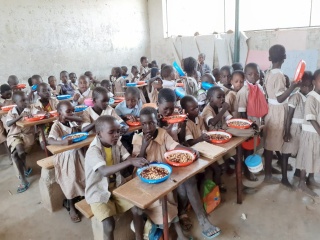
There Is an Urgent Need To Address Global Child Hunger and School Meals Could Be the Answer
Erin Pratley PhD, Director of Program Development & Operations at Mary’s Meals International shares on the growing issue of child hunger.

It’s easy to feel disheartened about the situation of hunger in our world today.
Last year, 29.6% of the global population (equivalent to 2.4 billion people) were moderately or severely food insecure. That’s an increase of more than 122 million people suffering the effects of hunger since 2019. These alarming figures were reinforced by the United Nations, which confirmed in July 2023 that the world is “far off track” from meeting its Sustainable Development Goal of ending hunger by 2030. In fact, it is projected that 600 million people will still be enduring hunger by the deadline – a sobering reminder of the scale of the task in hand.
In the decades preceding the COVID-19 pandemic, some progress had been made to reduce the number of hungry people in the world. Globally, undernourishment had declined from nearly 35% in 1970 to 12.9% in 2015, although levels in Africa and South America had remained alarmingly high. And sadly, much of the progress that had been made over recent years has now been lost because of recent global shocks, state fragility, economic landscapes and crises.
The pandemic had a catastrophic impact on people’s lives, as well as wreaking havoc on supply chains for distributing food around the world. People’s sources of income dried up overnight and lockdowns meant that opportunities for informal work also disappeared, at the very time widespread price rises and food shortages were gripping every corner of the globe. As ever, those who were already experiencing vulnerability because of food insecurity and poverty found themselves disproportionately affected. And just as the world started to get back on its feet after the pandemic, the war in Ukraine took hold and destabilized food supplies once more – a further blow to those already in dire need of respite.
There’s no denying the causes of hunger are complex. And many of them are also intrinsically linked so that isolated issues intersect and amplify each other. Poverty, war, displacement, rising costs, a pandemic or its aftermath, and climate change can and have affected countries at any given time. Governments and leaders face overwhelming challenges while more people slip deeper into hunger and poverty.
There is no one easy route to solving world hunger; none of the root causes of hunger could be solved overnight. To achieve our goal of zero hunger, it will take a concerted effort from people and organizations at all levels and a shift in attitudes and priorities. We need policies that tackle inequalities; sustainable food systems that empower smallholder production and meet the needs of all; financial commitments to transform agricultural practices; and mitigation of the impact of global shocks such as war, climate change and pandemics on the communities most vulnerable to them. What is reassuring, however, is that all of this is possible, and many individuals, governments and organizations are making great strides in the fight against hunger – but there is still much work to be done.
At the heart of the immense suffering caused by hunger around the world are children, the very youngest in society, who are silently paying the highest price. Just last year, 148 million children under the age of five were stunted and 45 million suffered from wasting – their health, physical and cognitive development and chance of gaining an education all in peril as a result. Robust efforts must be made to consistently, fairly and reliably to reach those children most in need of sustenance. School-feeding programs can be incredibly effective tools not only to alleviate immediate hunger among children but to promote access to education and help to break the cycle of poverty, paving the way for brighter futures for entire communities.
Mary’s Meals is reaching more than 250,000 children with daily school meals in East Africa, including in the Turkana region of Kenya. Recent research about the Mary’s Meals’ school-feeding program found that in Kenya two-thirds (68%) of the households sampled reported a change in their child’s health (increased weight, happiness, energy, less sickness and improved general health) since the arrival of free meals at their school. Before the meals, 88% of children reported they left school early sometimes because of hunger, and after Mary’s Meals started feeding, 81% never left early because of hunger. Consistent, reliable and nutritious school meals work to address children’s hunger and give a pathway to their education – we’re seeing the transformation before our eyes.
Hunger so often stands in the way of children’s readiness to learn, especially in environments where extreme poverty, conflict or displacement is prevalent. As children grow stronger – safe in the assurance that they will receive a meal at school – so, too, do their families and communities, especially when local people are actively involved in school meal program delivery. Over two decades, Mary’s Meals has seen the true power of its school-feeding program, which currently operates in 18 countries, collaborating with dedicated local communities that are battling hunger. What is evident in these environments is that households count on the meal at school for their child and value their child’s education. Community members invest time and resources in school feeding because they see the tangible benefits from the meal, and they are invested in the value of education for their children’s future. Coupled with a commitment to sourcing food as locally as possible, school feeding has the power to positively impact children, communities, and countries.
School-feeding programs play a key role in the complex fight against hunger and powerfully impact communities that bear the burden of global hunger and children who suffer most acutely. Even when focusing on the complexities of the issue in hand, it’s important to remember that children just want to be children – and meals served in school give them that chance.